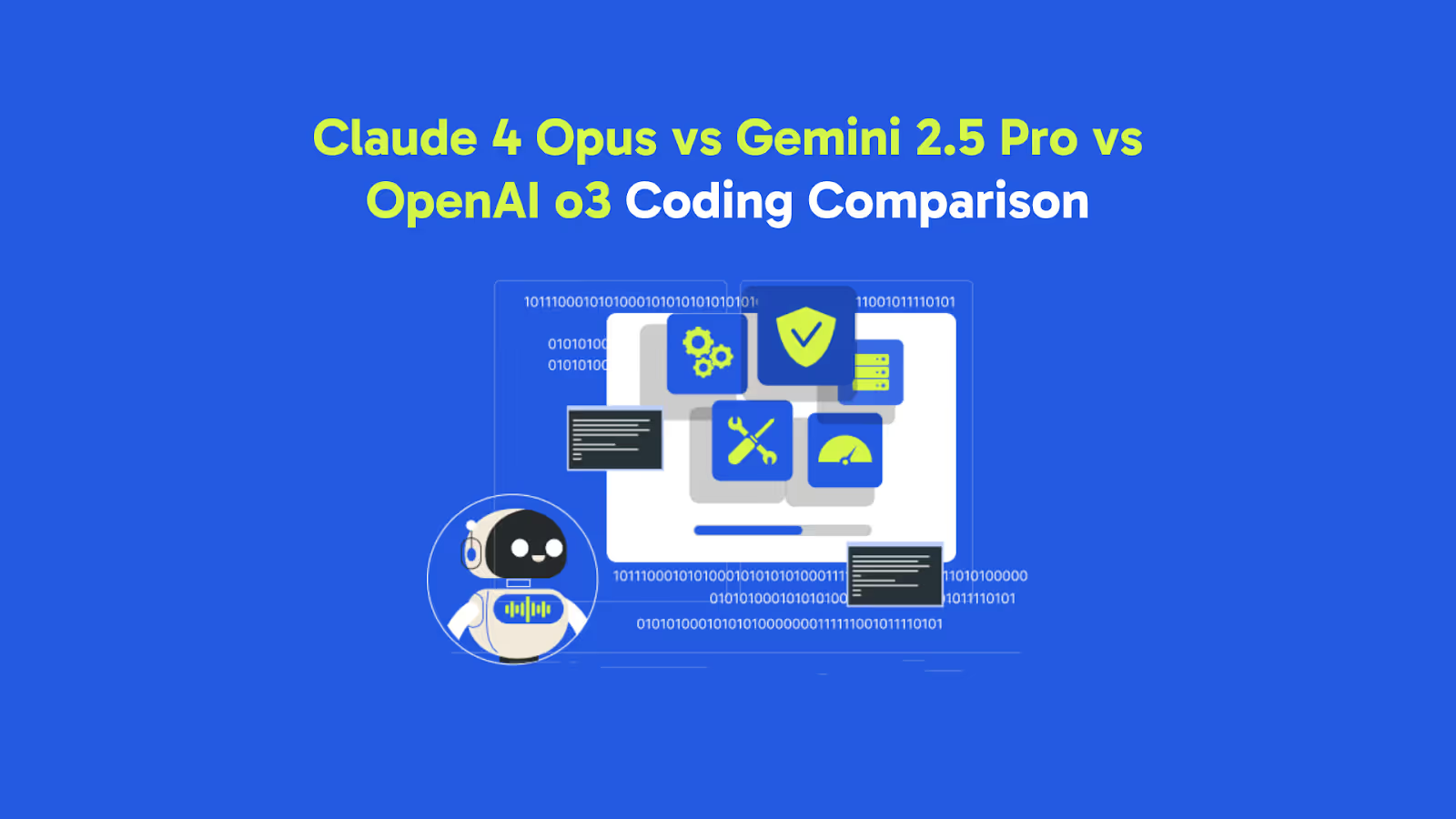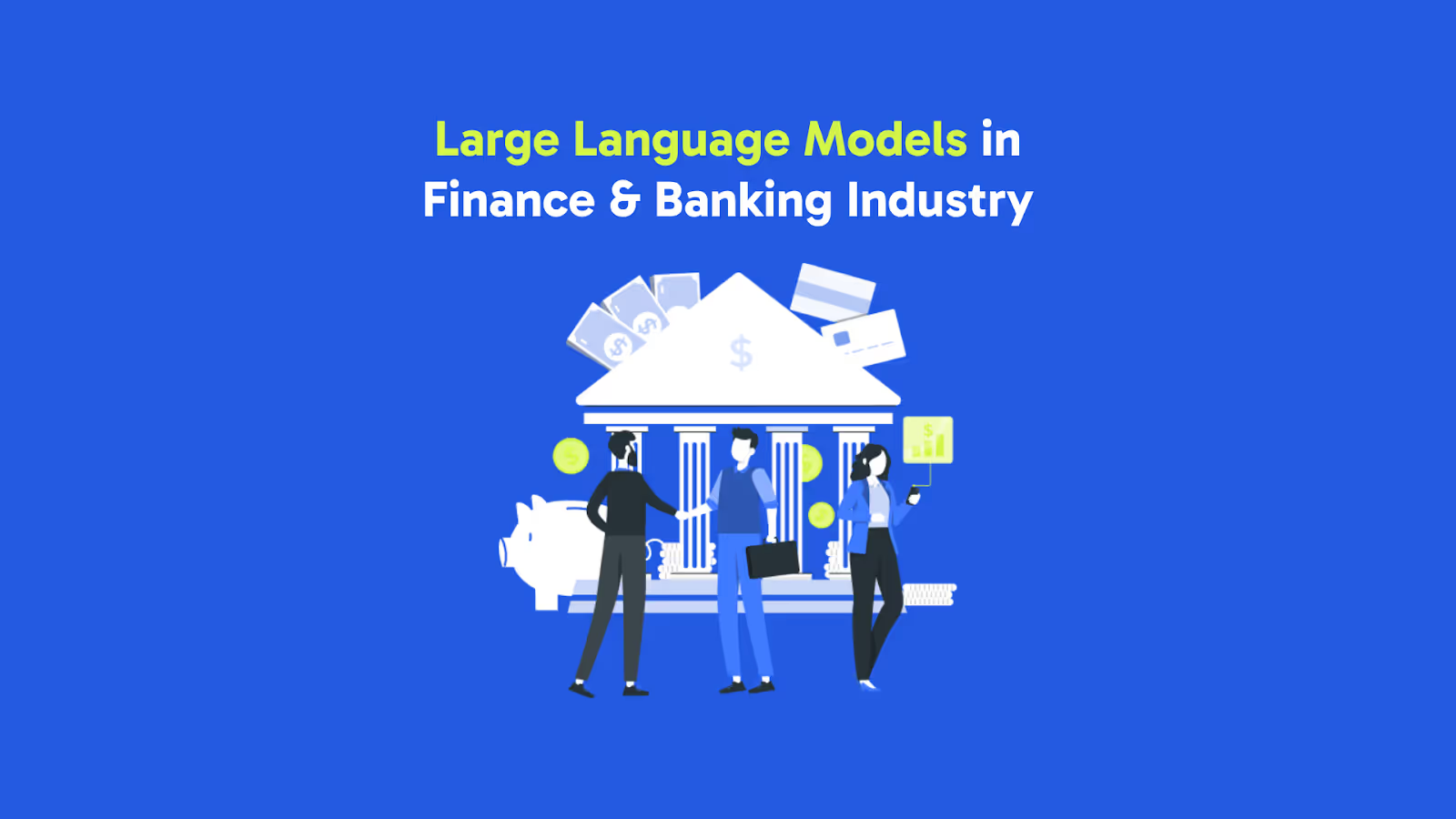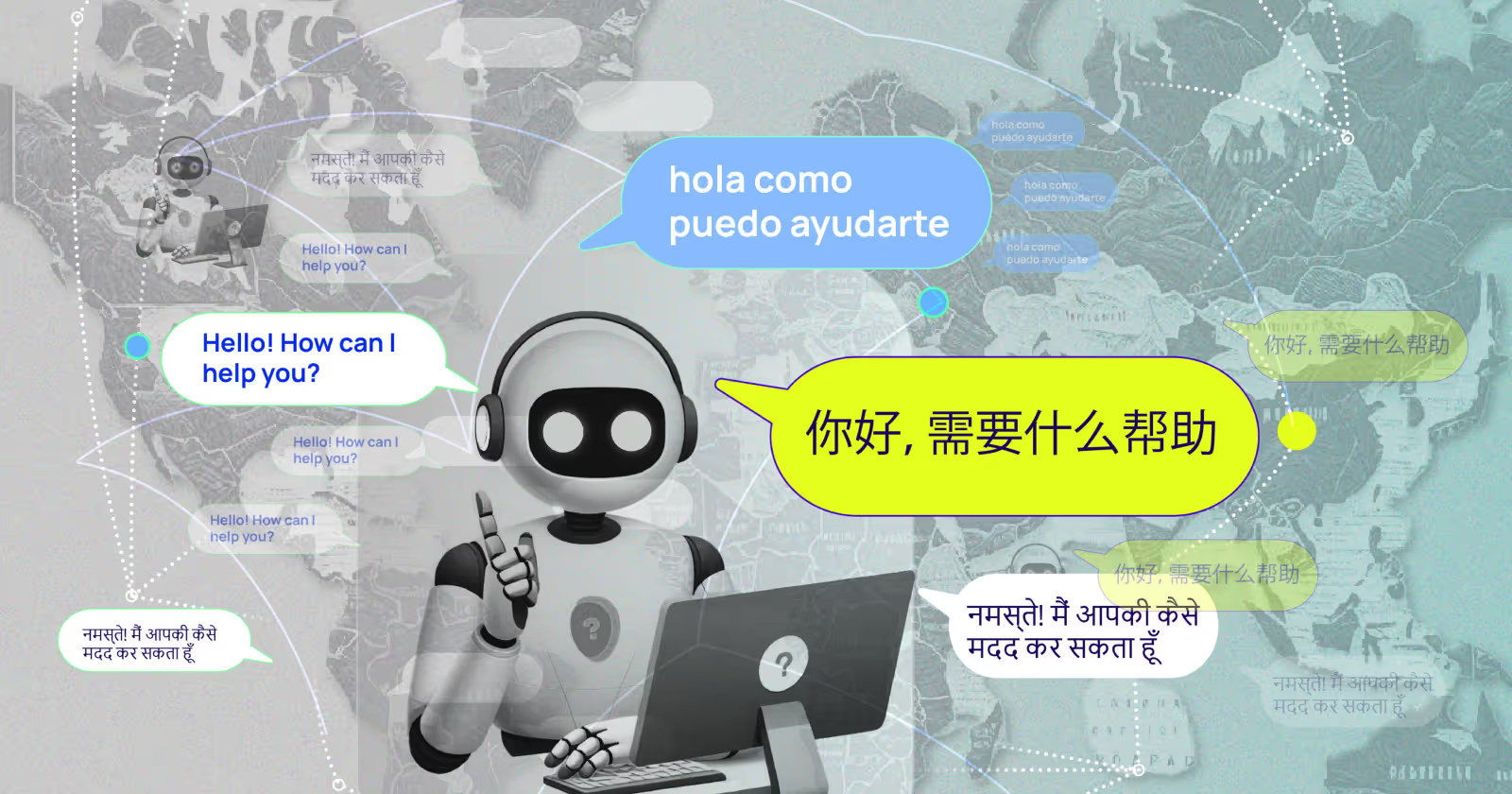Every business leader who’s tasked their team with building or updating software knows the frustration of choosing the right AI coding assistant, will it save hours or add headaches? The pressure to deliver results quickly while maintaining code quality can leave even experienced teams feeling stuck between options.
With Claude 4 Opus, Gemini 2.5 Pro, and OpenAI o3 each offering unique strengths, the challenge is less about finding a tool and more about finding the right match for your project’s rhythm and your team’s needs.
This comparison cuts through the noise, offering clear, practical insights into how each model handles real coding challenges. Whether you’re automating workflows, debugging legacy code, or building new features, understanding where these AI assistants excel, and where they might fall short, helps you make a confident choice that fits your business reality
Claude 4 Opus vs. Gemini 2.5 Pro vs. OpenAI o3: Model Overview
Each of these AI models, Claude 4 Opus, Gemini 2.5 Pro, and OpenAI o3, brings unique strengths to the table. Claude 4 Opus excels in deep reasoning and autonomous problem-solving, while Gemini 2.5 Pro balances efficiency with flexibility, ideal for large-scale data tasks. OpenAI o3 is built for high-performance tasks, offering advanced computational abilities for complex problems.
Let's take a closer look at what sets each of them apart.
What is Claude 4 Opus?
Claude 4 Opus is Anthropic's most powerful AI model, designed for complex reasoning and sustained performance on long-running tasks. Released in May 2025, it represents the pinnacle of Anthropic's AI capabilities with exceptional performance across multiple domains.
Key Features:
- Advanced Coding Capabilities: Leads industry benchmarks with 72.5% on SWE-bench and 43.2% on Terminal-bench, making it the current state-of-the-art coding model.
- Sustained Performance: Delivers consistent performance on tasks requiring focused effort over thousands of steps, with the ability to work continuously for several hours.
- Context Window: Supports a 200,000-token context window (approximately 300 pages of text).
- Extended Thinking Mode: Can switch from fast responses to slower, more deliberate reasoning for complex problem-solving.
- Memory Management: Creates and references persistent memory files to track key details across sessions.
- Output Capacity: Supports up to 32,000 output tokens for extensive generation.
What is Gemini 2.5 Pro?
Gemini 2.5 Pro is Google's most advanced AI model, purpose-built as a "thinking model" with improved reasoning as a core capability. Launched at Google I/O 2025, it combines cutting-edge research with practical design for real-world applications.
Key Features:
- Improved Reasoning: Features "Deep Think Mode" that evaluates multiple possibilities internally before responding, similar to an internal dialogue process.
- Massive Context Window: Supports a 1 million token context window, with plans to expand to 2 million tokens, making it the largest among these three models.
- Native Multimodality: Processes and generates content across multiple formats, including text, code, images, audio, and video within the same interaction.
- Advanced Math and Science Skills: Scored 86.7% on the AIME 2025 math benchmark and 84% on the GPQA diamond science benchmark.
- Coding Capabilities: Scored 63.8% on SWE-Bench Verified, generating and debugging code with the ability to test and refine solutions.
What is OpenAI o3?
OpenAI o3 is OpenAI's powerful reasoning model designed for complex tasks requiring deep analytical thinking. Released in April 2025, it's part of OpenAI's family of reasoning models that break down tasks into steps for more accurate responses.
Key Features:
- Reasoning Capabilities: Uses simulated reasoning to pause and analyze its internal thought processes before responding accurately.
- Context Window: Supports up to 128,000 tokens (approximately 300 pages of text).
- Multiple APIs Support: Available through Responses API and Chat Completions API with improved transparency through reasoning summaries.
- Multimodal Capabilities: Processes and analyzes visual data, extracting insights and generating comprehensive text outputs.
- Tool Integration: First reasoning model with full tool support, including parallel tool calling for agentic solutions.
- Memory and Personalization: Can remember user preferences between chats for more personalized responses, with toggleable memory controls.
While comparing these models head-to-head reveals their distinctive architectures, the real measure of their impact comes from how they translate strengths into practical coding results. Here’s how they stack up for developers seeking both power and precision.
Curious about how AI models are evolving and transforming industries? Discover more by exploring the evolution of GPT models in our detailed blog here.
Claude 4 Opus vs. Gemini 2.5 Pro vs. OpenAI o3 Coding Comparison
Each of these AI models, Claude 4 Opus, Gemini 2.5 Pro, and OpenAI o3, offers distinct approaches to problem-solving. Claude 4 Opus pushes boundaries with its deep reasoning and autonomous capabilities, while Gemini 2.5 Pro excels at handling large-scale data tasks with flexibility. OpenAI o3 stands out in its ability to tackle complex computational challenges, offering high-performance scalability.
Let’s compare their strengths and see which one fits your needs.
Benchmark Performance
To truly assess the capabilities of these models, we need to look beyond the surface and dive into their benchmark performance.
SWE-bench Scores
SWE-bench has emerged as one of the most important benchmarks for evaluating AI models' coding capabilities, measuring their ability to solve real-world software engineering tasks.
Terminal-bench Performance
When it comes to real-world coding applications, terminal-bench performance reveals how these models handle the most complex and demanding tasks.
Real-World Coding Capabilities
To fully understand how these models excel in coding tasks, it's essential to see how they perform in real-world coding challenges.
Code Generation
- Claude 4 Opus demonstrates superior code generation capabilities across various programming tasks, producing high-quality, functional code that closely adheres to requirements. In direct comparisons, it consistently outperforms both Gemini 2.5 Pro and OpenAI o3 in generating complex applications.
- When tasked with creating challenging applications like particle animations, games, and interactive systems, Claude 4 Opus delivers more complete, functional, and polished implementations compared to its competitors. Its code shows better structure, more comprehensive feature implementation, and fewer bugs.
- Gemini 2.5 Pro performs admirably in code generation tasks, though it typically falls short of Claude 4 Opus in terms of code quality and completeness. It excels in certain scenarios, particularly when generating code for well-defined problems with clear specifications.
- OpenAI o3 generally lags behind both Claude 4 Opus and Gemini 2.5 Pro in code generation tasks, often producing code with implementation issues and missing features. It struggles particularly with complex, multi-component applications that require coordinated functionality.
Code Debugging and Problem-Solving
Effective code debugging and problem-solving require more than just following instructions; they demand a model's ability to think critically and adapt to complex challenges.
- Claude 4 Opus excels at debugging and problem-solving, demonstrating superior reasoning capabilities when identifying and fixing issues in existing code. Its extended thinking mode allows it to break down complex bugs step by step, leading to more comprehensive fixes.
- Gemini 2.5 Pro features a "Deep Think Mode" that evaluates multiple possibilities internally before responding, similar to an internal dialogue process, which improves its debugging capabilities. However, it doesn't match Claude 4 Opus's debugging prowess in direct comparisons.
- OpenAI o3 introduces adjustable "reasoning effort" to allow deeper logical analysis of code issues, but often requires more iterations to solve complex debugging problems compared to Claude 4 Opus. It tends to be more confident in its incorrect solutions, making it sometimes harder to work with for debugging tasks.
Code Refactoring
Code refactoring is about optimizing structure and improving performance while ensuring long-term maintainability.
- Claude 4 Opus demonstrates exceptional capabilities in large-scale code refactoring, completing days-long engineering tasks in coherent, context-aware solutions across thousands of steps. It has been validated in demanding real-world scenarios, such as a 7-hour independent open-source refactor with sustained performance.
- Gemini 2.5 Pro performs well in code refactoring tasks but struggles more with changing code in large projects compared to Claude 4 Opus. Its massive context window does provide an advantage for understanding large codebases during refactoring.
- OpenAI o3 shows improvements in code refactoring compared to previous models, but still falls short of Claude 4 Opus in handling complex, multi-file refactoring tasks. It tends to be less consistent in maintaining context across large refactoring operations.
If you're interested in learning more about the most advanced large language models today, check out this insightful blog here.
Technical Specifications and Practical Considerations
When assessing any model, it’s important to balance technical capabilities with real-world constraints and practical applications.
Context Window Size
- Gemini 2.5 Pro offers the largest context window at 1 million tokens (with plans to expand to 2 million), giving it a significant advantage for analyzing entire codebases of up to ~30,000 lines in a single prompt. This massive context window eliminates the need for complex chunking and RAG pipelines for most projects.
- Claude 4 Opus supports a 200,000-token context window (approximately 300 pages of text), which is substantial but only a fifth of Gemini 2.5 Pro's capacity. This is still sufficient for most coding tasks, but may require more context management for very large codebases.
- OpenAI o3 supports up to 128,000 tokens (approximately 300 pages of text), which is the smallest among the three models but still adequate for most coding tasks. The limited context window compared to its competitors may require more strategic context management for large projects.
Pricing and Cost-Efficiency
The true value of any AI model lies in its ability to balance performance with cost, ensuring it meets both technical and budgetary needs.
Multimodal Capabilities for Coding
The ability to handle multiple forms of input and output at once sets some AI models apart, making them far more versatile in coding tasks.
- Gemini 2.5 Pro features native multimodality, processing and generating content across multiple formats, including text, code, images, audio, and video within the same interaction. This capability is particularly useful for analyzing screenshots alongside code, understanding diagrams and architectural schemas, and processing data visualizations.
- Claude 4 Opus processes and analyzes visual data, extracting insights and generating comprehensive text outputs, though its multimodal capabilities are not as extensive as Gemini 2.5 Pro's. It performs well on visual reasoning benchmarks but focuses more on text and code processing.
- OpenAI o3 can reason with images directly in its chain of thought, blending visual and textual reasoning while solving problems. This capability improves its performance across multiple visual reasoning benchmarks, though it's not as central to its coding functionality as its reasoning capabilities.
Practical Applications and Use Cases
Exploring how these models perform in real-world tasks reveals their true potential to solve complex challenges across various industries.
Enterprise Development
When scaling for enterprise success, it’s critical to examine how these models contribute to driving efficiency and meeting complex business demands.
- Claude 4 Opus excels in enterprise development scenarios, particularly for complex, mission-critical applications where code quality and reliability are paramount. It's ideal for large-scale debugging, complex problem-solving, and enterprise coding workflows that require sustained performance over long periods.
- Gemini 2.5 Pro offers a balanced approach for enterprise development, combining strong coding capabilities with cost-efficiency and a massive context window. It's particularly well-suited for projects involving large codebases and diverse data types.
- OpenAI o3 provides balanced performance with superior tool integration, making it well-suited for general enterprise needs and agentic applications that require coordination with external systems. Its strength lies in its versatility rather than specialized coding excellence.
AI-Assisted Coding
The true potential of coding expands when AI assists, not just automating tasks but improving creative problem-solving.
- Claude 4 Opus powers sophisticated agent architectures for complex, multi-step coding campaigns and workflows, making it ideal for AI-assisted coding tools that require a deep understanding of codebases and programming concepts.
- Gemini 2.5 Pro's massive context window and competitive pricing make it an excellent choice for AI-assisted coding tools that need to process entire codebases efficiently. Its ability to analyze entire codebases in a single prompt reduces the complexity of implementing AI coding assistants.
- OpenAI o3 offers full tools support including parallel tool calling for agentic solutions, making it suitable for next-generation agentic coding assistants that need to interact with multiple external systems. Its balanced performance makes it versatile for various coding assistance scenarios.
Individual Developers
For individual developers, the right tools can amplify creativity and streamline problem-solving, making them more capable than ever before.
- For individual developers, Claude 4 Opus offers the highest quality code generation and debugging assistance, though at a premium price point. It's particularly valuable for complex projects where code quality is critical and budget constraints are less significant.
- Gemini 2.5 Pro provides the best value proposition for individual developers, offering strong coding capabilities at a fraction of the cost of its competitors. Its free access options and economical pricing make it accessible to developers with limited resources.
- OpenAI o3 occupies a middle ground in terms of capabilities but at the highest price point, making it less attractive for individual developers compared to the alternatives. Its strengths in reasoning and tool integration may be valuable for specific use cases, but its cost limits its appeal for routine development work.
As these models differ in how they interpret and execute coding requests, the next logical step is to see them in action, where their unique approaches become clear through actual code examples and developer experiences.
Claude 4 Opus vs Gemini 2.5 Pro vs OpenAI o3: Coding Examples
As developers, understanding how different AI models approach coding can reveal new ways to improve your workflow and tackle complex problems. Let’s look at how Claude 4 Opus, Gemini 2.5 Pro, and OpenAI o3 perform with real coding examples to see where each model excels.
Example 1: Merge Two Sorted Linked Lists
Prompt:
Write a Python function to merge two sorted linked lists into one sorted linked list. Explain your approach and analyze its time and space complexity.
Claude 4 Opus
python
class ListNode:
def __init__(self, val=0, next=None):
self.val = val
self.next = next
def merge_sorted_lists(l1, l2):
dummy = ListNode()
current = dummy
while l1 and l2:
if l1.val < l2.val:
current.next = l1
l1 = l1.next
else:
current.next = l2
l2 = l2.next
current = current.next
current.next = l1 or l2
return dummy.next
# Approach: Uses a dummy node for simplicity, iterates efficiently.
# Time: O(n + m), Space: O(1)Gemini 2.5 Pro
python
def merge_sorted_lists(l1, l2):
head = tail = None
while l1 and l2:
if l1.val < l2.val:
node = l1
l1 = l1.next
else:
node = l2
l2 = l2.next
if not head:
head = tail = node
else:
tail.next = node
tail = node
tail.next = l1 or l2
return head
# Efficient, concise, but less explanation and modularity.OpenAI o3
python
def merge_sorted_lists(l1, l2):
if not l1:
return l2
if not l2:
return l1
if l1.val < l2.val:
l1.next = merge_sorted_lists(l1.next, l2)
return l1
else:
l2.next = merge_sorted_lists(l1, l2.next)
return l2
# Recursive solution, functional but less scalable for large lists.- Winner: Claude 4 Opus, Most modular, well-documented, and strong code.
- Runner-up: Gemini 2.5 Pro, Efficient and concise, but less readable and documented.
- Third place: OpenAI o3, Functional but recursive (risk of stack overflow), less strong.
Example 2: Refactor Recursive Fibonacci
Prompt:
Refactor this recursive Fibonacci function for efficiency and readability. Explain your changes.
Claude 4 Opus
python
def fib(n):
if n < 0:
raise ValueError("Input must be non-negative")
a, b = 0, 1
for _ in range(n):
a, b = b, a + b
return a
# Iterative, O(n) time, O(1) space, includes input validation.Gemini 2.5 Pro
python
def fib(n):
a, b = 0, 1
for _ in range(n):
a, b = b, a + b
return a
# Efficient, but no input validation.OpenAI o3
- Winner: Claude 4 Opus, Strong, efficient, includes error handling and comments.
- Runner-up: Gemini 2.5 Pro, Efficient and concise, but less strong.
- Third place: OpenAI o3, still recursive, not optimized for performance.
Example 3: Write Unit Tests for Email Validation
Prompt:
Write unit tests for the following email validation function. Cover edge cases and invalid inputs.
Claude 4 Opus
python
import unittest
class TestEmailValidation(unittest.TestCase):
def test_valid_emails(self):
self.assertTrue(is_valid_email("test@example.com"))
self.assertTrue(is_valid_email("user+tag@domain.co.uk"))
def test_invalid_emails(self):
self.assertFalse(is_valid_email("plainaddress"))
self.assertFalse(is_valid_email("@missingusername.com"))
self.assertFalse(is_valid_email("username@.com"))
def test_empty_string(self):
self.assertFalse(is_valid_email(""))
# Comprehensive, covers edge cases, well-structured.Gemini 2.5 Pro
python
import unittest
class TestEmail(unittest.TestCase):
def test_valid(self):
self.assertTrue(is_valid_email("a@b.com"))
def test_invalid(self):
self.assertFalse(is_valid_email("a.com"))
self.assertFalse(is_valid_email(""))
# Covers basics, but fewer cases.OpenAI o3
python
def test_email():
assert is_valid_email("test@example.com")
assert not is_valid_email("bademail")
# Minimal, not using unittest, lacks coverage.- Winner: Claude 4 Opus, Most comprehensive and structured tests.
- Runner-up: Gemini 2.5 Pro, Covers basics, less thorough.
- Third place: OpenAI o3, Minimal coverage, not using standard testing framework.
When these models generate code for the same prompt, their choices and explanations reveal which one might fit your project style or workflow, so the question becomes, which approach would best match your own coding needs and preferences?
For more insights on how AI is being applied across industries, you might find this blog on AI software examples and use cases interesting here.
Which AI Model Would Work the Best for You?
For businesses seeking the most capable AI coding assistant, Claude 4 Opus is the clear leader. It consistently delivers the highest code quality, best prompt adherence, and most strong solutions across real-world coding tasks, making it the top choice for enterprise development, code review, and automation needs. Its outputs are modular, maintainable, and reliable, critical factors for production environments and team workflows.
Gemini 2.5 Pro is the best option when cost-efficiency and large context windows are essential, offering strong performance at a fraction of the price, but it lags behind Claude in code sophistication and advanced editing.
OpenAI o3 is the most expensive and delivers only middling coding results, making it less attractive for businesses focused on software engineering, though it remains useful for general-purpose reasoning and tool integration.
Bottom line:
- Choose Claude 4 Opus for mission-critical, high-quality coding and automation at the enterprise level.
- Choose Gemini 2.5 Pro for budget-sensitive projects or large-scale document/code processing.
- Avoid OpenAI o3 for core coding tasks due to its high cost and inconsistent code quality.
This consensus is echoed across independent coding benchmarks, user reviews, and expert analyses in 2025.
Once you’ve chosen the right model, the next step is integrating it into your workflows. Whether it’s for support agents, dev workflows, or internal automation, deploying these models effectively requires the right infrastructure.
That’s where platforms like Nurix AI come in.
How Nurix AI Can Help with Claude 4 Opus, Gemini 2.5 Pro, and OpenAI o3
Nurix AI specializes in deploying advanced AI agents for customer support, sales, and business operations, integrating smoothly with leading language models like Claude 4 Opus, Gemini 2.5 Pro, and OpenAI o3. Their platform enables organizations to use the strengths of these models within real-world workflows, ensuring human-like conversations and rapid, scalable deployment.
Key Features of Nurix AI Solutions
- Human-like Voice and Text Interactions: Deliver natural, low-latency conversations powered by top-tier AI models, supporting both voice and chat channels.
- Rapid Integration: Connect instantly with existing CRM, telephony, and internal systems using a library of 300+ pre-built integrations.
- Fast Deployment: Launch AI agents in as little as 24 hours with customizable workflows and minimal setup.
- Always-on Support and Sales: Automate common tasks, resolve queries faster, and provide round-the-clock assistance.
- Customizable AI Architecture: Customize the underlying model and tech stack to your specific needs, using Claude 4 Opus, Gemini 2.5 Pro, or OpenAI o3 as required.
- Expert Consultation: Benefit from a team with deep expertise in large language models, cloud infrastructure, and enterprise AI deployment.
- Measurable Impact: Achieve improvements in sales conversions, customer satisfaction, and operational efficiency while reducing costs.
Nurix AI ensures that businesses can use the unique capabilities of Claude 4 Opus, Gemini 2.5 Pro, and OpenAI o3 within their operations, delivering value and a competitive edge.
Conclusion
Recognizing how Claude 4 Opus, Gemini 2.5 Pro, and OpenAI o3 each approach coding tasks gives business teams a clearer path forward, one that’s shaped by real results, not just marketing claims. When you know which model best matches your project’s complexity, style, and workflow, you avoid the trial-and-error that can slow down development and frustrate your team.
Armed with this understanding, you can choose an AI assistant that aligns with your priorities, whether that’s handling large codebases, quickly generating clean scripts, or supporting creative problem-solving. The right choice means fewer interruptions, smoother collaboration, and projects that move ahead with confidence, because the tool you pick should fit your process, not force you to adapt to it
Discover how Nurix AI empowers your business to use the best of Claude 4 Opus, Gemini 2.5 Pro, and OpenAI o3.
Get in touch with us to build AI agents that transform customer experience and drive measurable results.
FAQs About Claude 4 Opus, Gemini 2.5 Pro, and OpenAI o3
1. How do the models handle extremely long codebases or documentation?
Gemini 2.5 Pro stands out with its one million token context window, enabling it to process massive documents or codebases at once, while Claude 4 Opus and OpenAI o3 offer 200K tokens, which is still substantial but less for truly gigantic files.
2. What happens when you need to reference or cite technical sources or patents?
OpenAI o3 tends to include explicit contract numbers, patent IDs, and technical documentation in its outputs, making it more suitable for audit-ready or highly technical briefs. Claude 4 Opus compresses information into bullet points and avoids heavy citations, while Gemini 2.5 Pro often uses narrative storytelling and fictional references.
3. How do the models perform with multimodal tasks beyond text?
Gemini 2.5 Pro and OpenAI o3 offer strong multimodal capabilities. Gemini integrates with Google Workspace and supports images, while o3 handles voice, vision, and files. Claude 4 Opus supports text and images but lacks real-time voice or camera integration.
4. What are the real-world implications of each model’s reasoning style?
Claude 4 Opus is praised for its analytical, policy-style summaries and deliberate reasoning, making it ideal for busy decision-makers. OpenAI o3 delivers highly technical, data-dense responses, and Gemini 2.5 Pro leans toward imaginative, story-driven explanations.
5. How does each model’s pricing structure affect long-term project costs?
While all models are priced per token, Claude 4 Opus is generally more expensive for large outputs, OpenAI o3 offers strong value for general enterprise needs, and Gemini 2.5 Pro can be cost-effective for research tasks due to its massive context window and lower per-token pricing in some scenarios.










